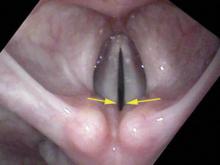If the vocal cords are going from the breathing in, V-shape toward a parallel position but they stop short of complete closure, this leaves a gap posteriorly. One example of this type of gap is muscle tension, where the opening muscles (PCA) partially tighten during phonation and hold the cords slightly apart, allowing air to escape between the back portion of the vocal cords.
Arrows lie along the direction of closure and point to the gap remaining between the vocal processes when there is incomplete closure.

